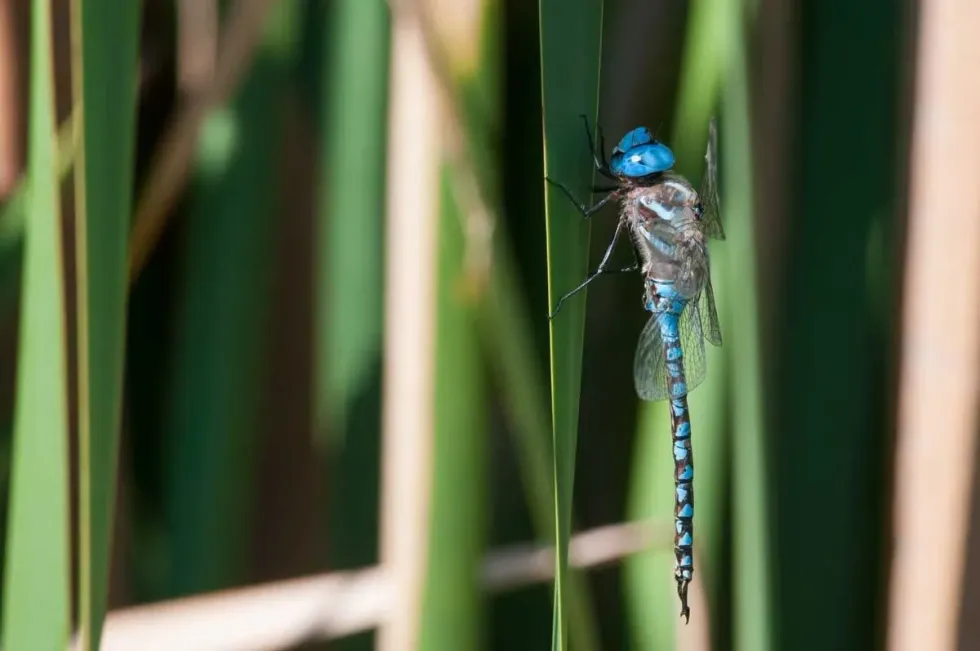The Blue-eyed darner (Rhionaeschna multicolor) is a common dragonfly species that are mostly found at the Snake river of the pacific north-west regions of the United States. When this species of dragonflies are found flying around, it indicates the time that spring begins.
They are the second most abundant dragonfly species that emerge in spring after the California darner. A man named Denny Johnson first discovered the blue-eyed darner (Rhionaeschna multicolor) in the city of Wisconsin in the year 2007.
Unlike other species of the genus Aeshna, these creatures have a unique bump on their underside abdomen segments, and their end is forked in shape. Male and female dragonflies are easily distinguishable as the males have large blue eyes while the females' eyes are yellow and green in color in place of blue.
Here we have gathered lots of amazing facts about the blue-eyed darner that everyone will surely enjoy. Let's look at a few of these interesting facts. If you like these, do also read about our crane fly and damselfly facts.
Blue-Eyed Darner Interesting Facts
What type of animal is a blue-eyed darner?
The blue-eyed darner (Rhionaeschna multicolor) is a dragonfly species of the Western United States.
What class of animal does a blue-eyed darner belong to?
The darner blue-eyed is an arthropod phylum that belongs to the class of Insecta and genus of Aeshna of the Aeshnidae family, similar to a dragonfly.
How many blue-eyed darners are there in the world?
The exact range of the population of the beautiful-eyed darner blue of the family Aeshna is not estimated as they have achieved major growth in the United States. These creatures are listed as potential species of concern in the state of Montana due to habitat destructions in the state.
Where does a blue-eyed darner live?
This darner (blue-eyed) is most common in the Snake River Plain of the United States and the western side of Canada in western Oklahoma and Texas. These are migratory dragonflies and can also be found in Mexico when migrating.
What is a blue-eyed darner habitat?
The habitat of the eyed darner (blue) is near water bodies, most likely lakes, ponds, open water streams, canals, freshwater currents, and moving water. But when these darner blue-eyed flies are not breeding, they can be found in urban locations, parking lots and, city yards.
Who does blue-eyed darner live with?
The eyed darner (blue) or Aeshna multicolor is usually found in groups of hundreds or thousands of darners, which are known as 'swarms of darners'. Sometimes, one of them is found alone, but they always make sure to be in close range to the group.
How long does a blue-eyed darner live?
The lifespan of blue-eyed darners is not very long, about two months only. They can live up to one year only, and half of their lifespan goes into maturing fully from being baby darners.
How do they reproduce?
The unique feature of the blue-eyed darner is that they mate during flight. Males show their abdomen, and females come in contact and fertilize themselves.
After it is done, females lay eggs on slow-moving waters. Once the eggs hatched, both males and females took care of their larvae and feed them with the aquatic insects from the ponds.
Once the young are old enough, they come out of the water, shed their skin which is then replaced with wings, and finally become adult darner flies.
What is their conservation status?
The conservation status of the blue-eyed darner flies has been listed as Least Concern by the IUCN Red List. They are in full growth and range in good numbers currently, but they could be Endangered if their habitat destruction continues to occur, such as in Montana.
Blue-Eyed Darner Fun Facts
What does a blue-eyed darner look like?
The adult male blue-eyed darner has large blue-colored eyes while females have the yellow-green color. Both species have transparent wings, and the size of their body are equally the same.
The color of their body is brown in color with unmistakable blue stripes on the abdomen. The wingspan of the adult blue-eyed darner species is around 4 in (10 cm) long and they have a forked end.
How cute are they?
The blue-eyed darner is a cute species of dragonfly. The large blue-colored eyes with the blue-colored stripes on the body are very attractive to behold. Apart from blue, their shiny transparent wings also look beautiful in contrast to their body.
How do they communicate?
Blue-eyed darners communicate with each other through a visual system that is present in their bodies. By using this system, they capture and detect their prey easily and quite easily identify the range of females and rival males.
How big is a blue-eyed darner?
The average size that a blue-eyed darner can get is up to 2.6-2.8 in (6.6-7.1 cm) in length. This species is five times smaller than a night parrot but comparatively bigger than other dragonflies.
How fast can a blue-eyed darner fly?
The average range of speed that the blue-eyed darner species can fly is more or less than 34.1 mph (55 kph). They're approximately six times faster than an average fly. These creatures can fly both upsides down as well as backward.
How much does a blue-eyed darner weigh?
The weight of the blue-eyed darner has not been estimated yet, but since they could rest on palm unnoticed, you could say they are super-light.
What are the male and female names of the species?
The adult does not have a specific name for females and males. They are just distinguished by their eye color.
What would you call a baby blue-eyed darner?
The baby blue-eyed darner does not have any specific name and is just known as a young one.
What do they eat?
The food that a blue-eyed darner prey on are the small aquatic insects, tadpoles, termites, small moths, freshwater shrimps, and sometimes they also eat small fishes. This diet is for the offspring and when the parents are in the breeding season.
Apart from these, when the darner is far away from water, they usually feed on flying insects like mosquitoes.
Are they poisonous?
No, the blue-eyed darner is not poisonous at all. These creatures do not sting but can bite hard if they feel threatened. The bite is not harmful but it sure is painful.
Would they make a good pet?
Blue-eyed darner dragonflies can be kept as pets. Although they are fun to raise, they are very challenging pets. It is better to let them stay wild as they feed on insects, and they are also migratory insects.
Did you know...
The blue-eyed darner has a vision of 360 degrees. That means they can see in all directions simultaneously.
What is the difference between arroyo vs blue-eyed darner?
These two species of dragonflies are very much alike that often people confuse them. The key difference between the arroyo darner and the blue-eyed darner is that the abdomen end of the blue-eyed is forked in shape while the arroyos are not.
Where does blue-eyed darner migrate?
The blue-eyed darner is a migratory arthropod as they usually migrate from spring to the end of the year. They mainly migrate to the state of California.
Here at Kidadl, we have carefully created lots of interesting family-friendly animal facts for everyone to discover! For more relatable content, check out these eastern carpenter bee or question mark butterfly
You can even occupy yourself at home by coloring in one of our free printable blue-eyed darner coloring pages.









